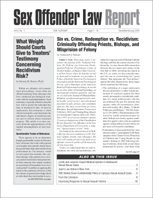Part II, The Efficacy of Rape Trauma Syndrome Evidence: Implications for Policy and Research
Author: Douglas D. Koski, JD, PhD.; Roslyn Myers, Esq..
Source: Volume 02, Number 06, October/November 2001 , pp.81-86(6)

next article > |return to table of contents
Abstract:
This is the second part of a series presenting the findings of the first study in the United States applying the “story model” of jury decision-making to rape cases in which the defense is that of consent. Part I, presented in the last issue of SLR, described the effects of rape on victims, the view of date or acquaintance rape by criminal justice professionals, and admissibility of social scientific data, such as evidence of rape trauma syndrome (RTS), in criminal rape litigation. In contrast to the story model, the study in Part I showed that jurors look for a story that will justify the verdict they intuitively select. Because instructions to juries contemplate that the victim may be falsely accusing the defendant, “false allegation” is readily available to people who would argue not-guilty. Because juries are not instructed on RTS, an “RTS-plot” is not readily available to people who would argue guilty. The study demonstrated that several jurors in the study tried to construct a “RTS plot,” but were unable because they had nothing to fall back on—no legally mandated ground supported by the instructional law. Part II, presented below, offers suggestions for improving the efficacy of RTS evidence by modifying the instructions given jurors.Keywords:
Affiliations:
1: Rutgers University School of Criminal Justice, Distinguished Research Fellow; 2: Managing Editor of SLR.